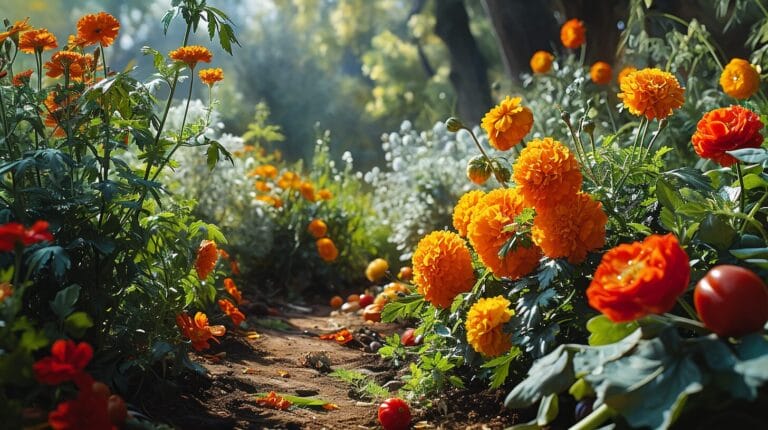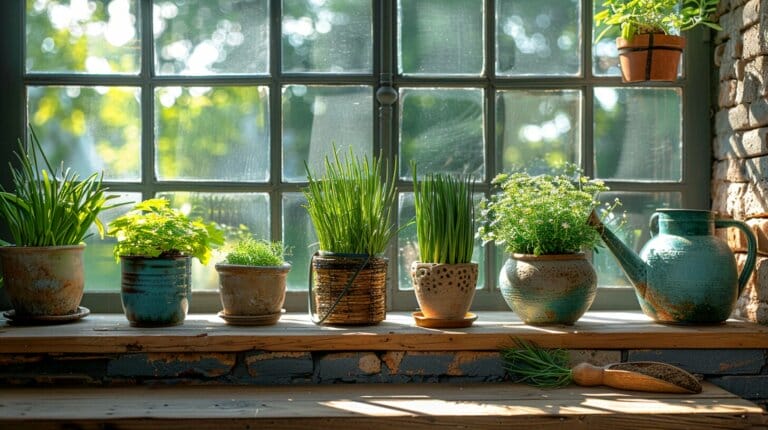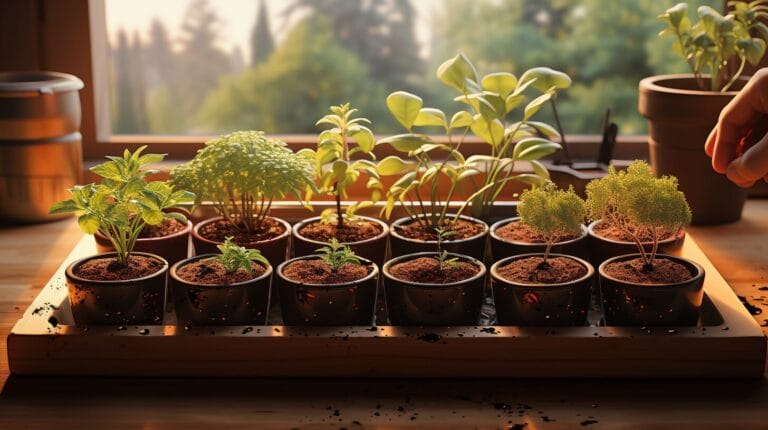Low Maintenance Hedge Plants: Enjoy A Beautiful Garden with Less Work in 2024
Ever felt captivated by the enchanting charm of hedge plants? I know I have, and it seems like I’ve discovered a remarkable value. Think about a luxurious garden, radiating utmost excellence but demands minimal hard work to maintain. This is all within easy reach with the easily maintainable hedge plants.
They’re quick to grow, add privacy, and boost curb appeal. Plus, they’re a breeze to care for. Whether you’re looking to transform your landscape quickly, want a fragrant flowering hedge, or need hardy perennials for year-round appeal, I’ve got you covered.
Let’s dive into the beauty and benefits of these wonderful plants together.
Key Takeaways
- Low-maintenance hedge plants provide benefits such as enhancing privacy, boosting curb appeal, and acting as natural air filters.
- Maintaining low-care hedges brings joy and satisfaction with minimal effort required.
- Fast-growing hedges like Viburnum, Privet, and Mexican Orange Blossom offer quick landscape transformations with low maintenance.
- Fragrant flowering hedge plants like Escallonia, Lavender, and Mock Orange provide a sensory experience while requiring occasional trimming and attracting pollinators.
The Beauty and Benefits of Low Maintenance Hedge Plants
I’ve always found low-maintenance hedgerow foliage to be a great way to enhance privacy and add curb appeal to any property.
Not only do they look beautiful, but they also support our ecosystem in ways we mightn’t realize. And let’s not forget about the joy and ease that comes with maintaining these low-care hedges.
Enhancing Privacy and Curb Appeal with Hedges
I’m always amazed by the number of benefits a well-placed, low-maintenance hedgerow foliage can offer, from enhancing privacy to boosting curb appeal.
Creating the perfect hedge is an art, and choosing the best low-maintenance hedge plants is the key.
A privacy hedge, for instance, not only shields your home from prying eyes but also adds a touch of natural beauty to your property.
Moreover, enhancing privacy and curb appeal with hedges doesn’t have to be an arduous task. With a little know-how and the right choices, you can easily create a stunning, low-maintenance green screen that not only protects your privacy but also increases your home’s aesthetic appeal.
It’s time you embraced the beauty and benefits of low-maintenance hedgerow foliages.
Environmental Impact and Ecosystem Support of Hedge Plants
Before we move on, let’s not forget that, in addition to their aesthetic appeal, these low-maintenance hedgerow plants also have a significant positive environmental impact and play a crucial role in ecosystem support by acting as natural air filters, dark green leaves in hedges help to reduce pollution, thus contributing to an overall healthier environment.
Their dense foliage, depending on the variety, provides privacy and shelter for a variety of wildlife. These evergreen foliage hedges are particularly effective in providing both privacy and food for local ecosystems. In contrast, deciduous plants may offer privacy during the growing season, as they feature dark green leaves, but they shed their leaves during the winter months.
Their dense foliage provides shelter and food for a variety of wildlife, supporting local ecosystems.
It’s worth noting that the environmental impact of a hedge plant extends beyond the immediate surroundings. They also assist in soil conservation, preventing erosion and maintaining soil fertility. When it comes to low maintenance, slow-growing evergreen hedges or borders are the way to go.
These tolerant plants that need little attention are best suited for those who prefer space-saving and low-maintenance landscaping options in the UK.
Whether you’re looking to choose the best low-maintenance hedge plants for your garden or are interested in growing in full sun, hedges also serve as an effective hedge against soil erosion, helping to stabilize the soil. By selecting the right plants, you can create an attractive privacy screen that is not only aesthetically pleasing but also environmentally friendly.
The Joy and Ease of Maintaining Low-Care Hedges
Often, I find immense joy and satisfaction in maintaining my low-care hedges, as they’re not only stunning to look at but also require minimal effort to keep healthy and vibrant. Choosing the right hedge plant for your garden is crucial to ensure this joy and ease. Green foliage is the key to the beauty of these hedges.
Low-maintenance hedges aren’t just about beauty; they’re also about smart gardening. These easy-care space plants are a boon for those who’ve busy lives but still wish to have a green, serene environment at home.
The ease of maintaining low-care hedges allows me to focus more on enjoying my garden rather than spending countless hours in upkeep. It’s the simplicity and resiliency of these hedges that make me appreciate them more. These plants grow effortlessly, which is best done when you choose the right ones for your specific garden conditions.
Truly, there’s nothing more fulfilling than a garden that’s both beautiful and easy to manage. Plants need minimal attention, making them ideal for those living in the UK. Choosing the right plant for hedges can significantly enhance the appeal of your garden. Hedges offer not only beauty but also privacy and a sense of enclosure in your outdoor space.
Fast-Growing Hedges for Quick Landscape Transformations

Let’s now turn our attention to quick-growing hedges that can quickly transform your landscape.
We’ll start with the resilient and speedy Viburnum hedge. Move on to the beautiful Privet hedge. And finish with the vibrant and quickly developing Mexican Orange Blossom. These plants offer not only low maintenance but also rapid growth for those seeking an immediate change.
The Resilient and Fast-Growing Viburnum Hedge
I’m going to talk about the Viburnum hedge, a resilient and quick-growing plant ideal for quick terrain transformations. This low-maintenance hedgerow is the perfect option if you’re seeking an easy-to-care-for hedge for your garden.
What makes the Viburnum the go-to choice for growing hedges?
Here are a few key reasons:
- Its quick-growing nature allows for quick privacy and aesthetic improvements.
- The Viburnum is known for its resilience, thriving in various soil types.
- It’s a low-maintenance hedge, requiring minimal pruning and upkeep.
- With an array of species, there’s a Viburnum variety to suit every garden style.
- Its attractive and dense foliage makes it an ideal choice for creating boundaries.
The Speedy and Beautiful Privet Hedge
Next, we’ll delve into the speedy and beautiful Privet hedge, a plant that’s not only quick-growing for quick land-setting transformations but also an adornment in any outdoor space. Among the best fast-growing hedges, the Privet holds its own, offering a beautiful hedge that captivates the eyes and enlivens the scene.
As a low-maintenance plant, it’s perfect for those of us who love gardening but don’t have the luxury of time. The Privet’s rapid growth rate makes it ideal for growing hedge plants, as it quickly forms a dense, lush green wall. Its speediness doesn’t compromise beauty, making it a favorite among those seeking a beautiful, low-effort terrain.
Thus, the speedy and beautiful Privet hedge is a gem worth considering for your garden.
The Vibrant and Quick-Developing Mexican Orange Blossom
After covering the Privet, I’m now turning my attention to the vibrant and quick-developing Mexican Orange Blossom, a plant that, with its fiery hues and rapid growth, serves as a real showstopper in the garden and a quick solution for land-setting transformations.
This blooming hedge is among the best low-maintenance hedgerow plants, and its traits are quite appealing:
- The Mexican Orange Blossom’s stunning, vibrant orange blooms are a sight to behold.
- It’s one of the quick-growing hedges, ideal for quick landscape transformations.
- With its aromatic leaves, it adds a sensory experience to your garden.
- It’s able to grow well in various conditions, making it a versatile choice.
- Its low maintenance needs mean less work for you while still providing an appealing barrier.
End your search for the perfect hedge with the Mexican Orange Blossom.
Fragrant Flowering Hedge Plants for a Sensory Experience

I’m excited to introduce you to some scented blooming hedge plants that require little maintenance and offer a delightful sensory experience. Imagine enjoying the year-round blooms of the easy-care Escallonia or the delightful aroma of the low-maintenance Lavender hedge.
If you’re looking for resilience combined with fragrance, you can’t go wrong with the hearty Mock Orange hedge.
Enjoy the Year-Round Blooms of the Easy-Care Escallonia
In my garden, there’s nothing I appreciate more than the year-round blooms of the low-maintenance Escallonia, a scented blooming hedge plant that provides a sensory experience. This evergreen shrub requires little maintenance, making it easy to maintain and a delight to have in any garden.
Here are a few things that make Escallonia stand out:
- Its flowers bloom year-round, providing constant color.
- It’s an evergreen shrub, ensuring your garden stays green even in winter.
- It requires little maintenance, which is perfect for a busy gardener like me.
- It’s easy to maintain, requiring just a quick trim now and then.
- It flowers in spring, adding a burst of color when you need it.
Simply put, the Escallonia is a gardener’s dream.
The Delightful Aroma of the Low-Maintenance Lavender Hedge
I can’t get enough of the delightful aroma that wafts from my low-maintenance Lavender hedge, a scented blooming hedge plant that provides a truly sensory experience. This best low-maintenance hedgerow is a gift to any garden, offering aesthetic appeal and an unbeatable scent.
Thinking about growing a hedge? Consider lavender. It’s easy to plant a hedge of lavender, perfect for those looking for a simple yet rewarding gardening project.
Here’s a quick comparison of lavender with other plants for your garden:
| Lavender | Other Plants |
| Easy to Maintain | It may not offer an aroma |
| Fragrant | It may not offer an aroma |
| Evergreen | Can be deciduous |
| Drought tolerant | May need regular watering |
| Attracts pollinators | May not offer an aroma |
Experience the delightful aroma of the low-maintenance lavender hedge and transform your garden into a sensory haven.
The Fragrant and Resilient Mock Orange Hedge
Let’s now move on to my personal favorite, the fragrant and resilient Mock Orange hedge, an aromatic blooming hedge plant that’s certain to enhance any garden with its sensory appeal. This is an evergreen shrub that produces beautiful white flowers. It’s not just the fragrance that makes this the perfect hedge.
There’s more to it:
- It’s one of the best low-maintenance plants you could choose.
- It’s easy to care for, needing only simple pruning.
- The white flowers provide a visual treat.
- It grows in various soil types.
- It’s resistant to most garden pests.
If you desire a garden that’s not only easy to maintain but also provides a sensory experience, the Mock Orange hedge is the ideal choice.
Hardy Perennial Hedges for Year-round Appeal

Now, let’s talk about the hardy perennial hedges that hold their appeal all year round. I’m going to touch on three varieties that aren’t only low-maintenance but also have their unique charms.
These are the evergreen Yew, the vibrant Holly, and the visually striking Boxwood hedges.
The Evergreen and Low-Maintenance Yew Hedge
In my experience, there’s no better choice than the Yew hedge if you’re looking for a low-maintenance plant that provides year-round appeal thanks to its evergreen nature and hardiness. This hedge is a winner when it comes to fostering a serene, leafy environment.
Here are some main reasons why it’s my go-to:
- Evergreen: It provides constant greenery, maintaining its lush appearance throughout all seasons.
- Low maintenance: It requires minimal care. Regular watering and occasional feeding are all it takes.
- Prune-friendly: It responds well to pruning, allowing you to shape them to your liking.
- Hardy: They are robust, tolerating a wide range of soil conditions and climates.
- Year-round appeal: Its vibrant green leaves and red berries add a pop of color, brightening up your garden throughout the year.
The Vibrant and Hardy Holly Hedge
I’ve grown quite fond of the vibrant Holly hedge, and it’s not just because of its striking appearance but also due to its robust nature. This evergreen hedge is adorned with glossy green leaves and vivid red berries, presenting an eye-catching display all year round. The Holly is slow growing, which means less maintenance and more time enjoying its beauty.
Let’s delve into a few key details:
| Aspect | Description | Benefit |
| Type | Holly | Hardy perennial, perfect for year-round appeal |
| Characteristics | Evergreen hedge, green leaves, red berries | Provides color and texture throughout the seasons |
| Growth Rate | Slow growing | Requires less frequent trimming, making it a low-maintenance choice |
Incorporating a Holly hedge into your garden design ascertains both aesthetic and practical benefits.
The Resilient and Visually Striking Boxwood Hedge
While I’ve come to appreciate the Holly, it’s the Boxwood hedge that captures my interest, both for its resilience and its striking visual appeal. As one of the best low-maintenance options, it’s often used for hedges to make your garden look immaculate year-round.
Boxwood, one of the best hedge plants, offers several key advantages:
- It’s hardy and resistant to pests and disease.
- It flourishes in a variety of soil conditions.
- Its compact growth makes it a top choice for ornamental shrubs.
- It requires minimal pruning, making it a low-maintenance option.
- Its deep green leaves retain their color throughout the year, adding a year-round appeal.
These attributes make Boxwood a preferred choice for those seeking a resilient, visually striking hedge.
Designing and Caring for Your Low-Maintenance Hedge

Now, let’s switch gears to talk about designing and caring for your low-maintenance hedge.
We’ll start by discussing where and how to plant your hedge, then move on to essential care tips such as watering, fertilizing, and pruning.
Don’t worry; we’ll also touch on how to protect your hedge from common plant diseases and pests.
Tips on Where and How to Plant a Hedge for Your Garden
Let’s dive right into how and where you should plant a low-maintenance hedgerow for your planting area. To successfully incorporate it into your garden, you need to consider the location, soil, and the type of hedge plant.
Here are some tips on where and how to plant a hedge for your planting area:
- Choose the best hedges that require minimal attention. Some low-maintenance hedgerow options include Privet, Boxwood, and Yew.
- Plant your hedge in a spot that gets ample sunlight. Most hedge botanicals thrive in full sun or partial shade.
- Ensure your soil is well-draining. Hedges don’t like waterlogged conditions.
- Space your hedges properly to allow room for growth.
- Prune your hedges regularly to maintain their shape and health.
Carefully chosen and well-placed hedges will enhance your garden’s aesthetic appeal.
Key Care Tips: Watering, Fertilizing, and Pruning Low-Maintenance Hedges
Having selected and planted your low-maintenance hedge, I’m turning our attention to the key care tips, which include watering, fertilizing, and pruning, all critical for maintaining a healthy and attractive garden feature.
Watering your low-maintenance hedgerow plant isn’t a daily necessity, but during dry spells, it’s essential to keep the soil moist.
Fertilizing is another crucial aspect of hedge care. I’d suggest an annual application of a slow-release granulated fertilizer to provide your hedge with the necessary nutrients.
Lastly, let’s talk about pruning low-maintenance hedges. I recommend a yearly trim to maintain shape and encourage dense growth.
You can watch more tips and guidelines for caring for your hedge botanicals in this video:
Protecting Your Hedge from Common Plant Diseases and Pests
Where should we focus next in our journey towards a low-maintenance hedge?
I’ll tell you how to prevent common plant diseases and pests that could potentially harm your hedge. Protecting your hedge is just as vital as picking the best plants. It’s all about maintaining healthy, vibrant hedges that provide the perfect garden privacy.
Here’s a handy list to help you keep common plant diseases and pests at bay:
- Regularly inspect your low-maintenance hedge plant for signs of disease or pests.
- Utilize natural pest control methods whenever possible.
- Choose disease-resistant hedge botanicals.
- Maintain proper spacing between plants to improve air circulation.
- Prune your hedges regularly to eliminate diseased or pest-infested branches.
Conclusion
In the end, there’s nothing like a low-maintenance hedgerow to spruce up your landscape. Fast-growing, fragrant, and hardy, these hedges are the perfect blend of beauty and convenience.
With careful design and minimal care, they can transform your garden into a lush, sensory experience. I’m a big fan of these effortless green giants, and I highly recommend them to anyone looking to add a touch of nature to their space without the fuss of high-maintenance plants.
Frequently Asked Questions
What Kind of Pests Are Low-Maintenance Hedgerow Plants Susceptible to, and How Can They Be Managed?
In my experience, aphids and scale insects often plague hedges. I manage these pests by introducing beneficial insects, using insecticidal soap, or applying horticultural oil. Regular monitoring helps catch infestations early.
Are There Any Potential Allergens People Should Be Aware of Before Planting Low-Maintenance Hedgerows?
Some folks might be allergic to specific hedge plants. Common allergens include pollen and sap. It’s essential to research each plant’s potential allergens before choosing the right low-maintenance boundary plants for your yard.
Can Low-Maintenance Hedgerow Plants Survive in Shaded Areas, or Do They Need Direct Sunlight?
In my experience, many low-maintenance hedgerow plants can thrive in shaded areas. However, they’ll typically grow slower and may not be as dense. Direct sunlight usually promotes faster and fuller growth.
What Is the Average Lifespan of a Low-Maintenance Hedgerow Plant?
In my experience, the average lifespan for these types of plants can significantly vary. Most, however, can thrive for 20 to 30 years, given the right conditions and a bit of care.
Are There Any Types of Soils That Are Particularly Unsuitable for Growing Low-Maintenance Hedgerow Plants?
Most low-maintenance hedgerow plants don’t do well in waterlogged or heavy clay soils. They prefer well-drained soil. Overly sandy soils can also be a problem as they lack nutrients.







